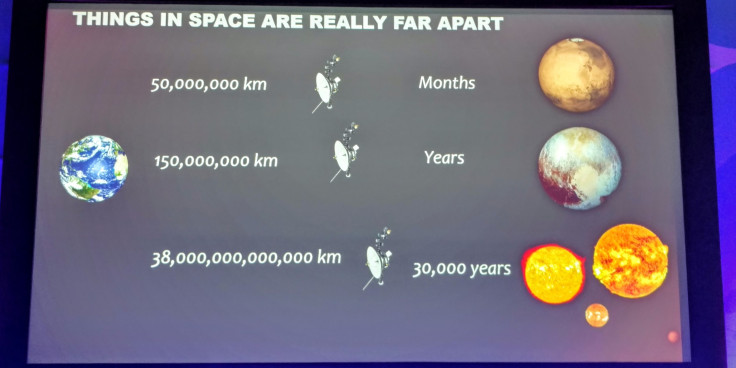Interstellar Space Travel: Antimatter-Powered Rockets Could Make It A Reality

LONDON -- The current technology behind our space travel isn't nearly powerful or efficient enough to get us anywhere near our closest star system. That's why one company is developing an antimatter-powered rocket that could increase space travel by a factor of 1,000.
The Voyager 1 space probe is the fastest man-made object ever invented. It can travel 14 kilometers every second, and it left our solar system a couple of years ago. But when you consider Voyager 1 launched back in 1977, that doesn't seem like such a major achievement. Our closest neighbor, Andromeda Galaxy, is 2.5 million light-years from Earth.
"The problem is that [14 kilometers a second] is really slow. The reason is that things in space are incredibly far apart," Ryan Weed told the Wired 2015 conference in London on Friday. "It's clear that we need much better rockets, we need a much better way to get out of here."
Annihilation
Weed is the co-founder and CEO of Positron Dynamics, which is trying to build the first antimatter rocket. To do this, Weed wants to harness something called annihilation: "Annihilation is a property of antimatter that is very unique. You have a block of antimatter, you hit it next to matter and annihilates into pure energy. It is the purest form of mass-to-energy conversion you can get.
To explain just how powerful this property is, Weed said that if you smashed 20 grains of salt into 20 grains of anti-salt, you would get the same amount of energy as 4 million pounds of rocket fuel -- or, to think of it another way, those 20 grains of anti-salt could create the same amount of energy the whole of London uses in 24 hours.
Harnessing such power, according to Weed, would enable an antimatter rocket to orbit Earth in three seconds, travel to Mars in a matter of weeks, reach Pluto in months and make it the 38 million-million kilometers to Alpha Centauri in around 40 years -- significantly less than the 30,000 years it would take Voyager 1.

But this is simply not possible with today's technology. The problem is that positrons, the antimatter particles that collide with electrons to yield that huge amount of energy, cannot be cooled down efficiently -- and they need to be cool in order to be controlled. "With the current state of the art in positron cooling, you throw away 999 out of 1,000 positrons, so it is very inefficient," Weed explained.
Nuclear Fallout
Taking up this challenge, he and his team at Positron Dynamics have filed a patent for a system to "cool down positrons efficiently using cross-magnetic and electric fields in combination with semiconductor material." Having figured out that working on nuclear physics in an office building wasn't the smartest idea, the company moved operations to a nuclear fallout shelter and is working toward launching a shoeboxed-sized satellite into orbit, powered by positrons.
An antimatter-powered rocket traveling to our closest star system may be a long way off, but in the short term, this technology could help power constellations of satellites that companies like Google, Samsung and SpaceX are looking to launch in the next few years. Google Skybox, for instance, wants to create a live version of Google Map, and Samsung is looking to launch 5,000 satellites to create a global broadband network.
While the cost of launching small, low-orbit satellites has come down to $20,000, an array that size would be costly, especially as they don't stay in orbit very long.
What Weed's positron-propulsion system promises is a significant reduction in costs as well as lasting for seven years at a lower orbit, which could offer increased broadband speeds and high-resolution imagery. So while the dream of reaching another solar system is still a long way away, there is some hope that this new system could power the next generation of space travel.
© Copyright IBTimes 2025. All rights reserved.





















